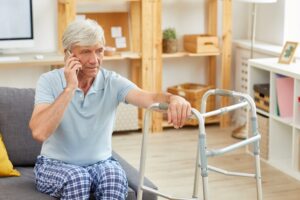Falls are a common problem among older adults, often leading to serious injuries. However, many falls can be prevented by making simple modifications to the home environment and adopting safe habits. This blog post will provide practical tips to help seniors and caregivers reduce the risk of falls.
Common Causes of Falls
- Slippery surfaces: Wet floors, spills, or loose rugs can be hazardous.
- Poor lighting: Insufficient lighting can make it difficult to see obstacles.
- Clutter: Obstacles such as cords, furniture, or toys can create tripping hazards.
- Unstable furniture: Chairs, tables, or stools that are not sturdy or have wobbly legs can contribute to falls.
- Medication side effects: Some medications can cause dizziness, balance problems, or drowsiness, increasing the risk of falls.
- Medical conditions: Conditions such as arthritis, Parkinson’s disease, or stroke can impair balance and coordination.
Home Safety Tips
- Improve Lighting:
- Install brighter light bulbs in key areas like hallways, bathrooms, and stairways.
- Use nightlights or motion-activated lights for added visibility.
- Consider installing a light switch near the bed for easy access at night.
- Address Slipping Hazards:
- Clean up spills promptly.
- Use nonslip mats or rugs on slippery surfaces.
- Install grab bars in the shower and bathtub.
- Use a nonslip bath mat.
- Reduce Clutter:
- Remove unnecessary items from walkways and stairways.
- Secure cords and cables to prevent tripping hazards.
- Keep furniture and objects away from doorways and stairways.
- Improve Furniture Stability:
- Ensure chairs, tables, and stools are sturdy and have non-slip feet.
- Consider using furniture stabilizers for added support.
- Install Safety Features:
- Install handrails on both sides of stairs.
- Use grab bars in the bathroom and near the toilet.
- Consider installing a wheelchair ramp if necessary.
- Review Medications:
- Work with your healthcare provider to review your medications and address any side effects that could increase the risk of falls.
- Consider adjusting dosages or switching medications if necessary.
- Address Medical Conditions:
- Work with your doctor to manage any underlying medical conditions that could contribute to falls.
- Participate in physical therapy or balance training to improve strength and coordination.
- Wear Appropriate Footwear:
- Wear well-fitting shoes with non-slip soles.
- Avoid wearing loose-fitting clothing that could cause tripping.
- Use Assistive Devices:
- If you have difficulty walking or standing, consider using assistive devices such as a cane, walker, or wheelchair.
- Create a Safe Outdoor Environment:
- Clear walkways of debris and obstacles.
- Install outdoor lighting for better visibility at night.
- Consider using a nonslip coating on outdoor steps and walkways.

Additional Tips for Caregivers
- Monitor the care recipient closely: Keep an eye on the care recipient’s balance and gait.
- Provide assistance when needed: Offer support when necessary, especially when walking or climbing stairs.
- Encourage regular exercise: Physical activity can help improve strength, balance, and coordination.
- Educate the care recipient: Teach the care recipient about fall prevention measures and encourage them to follow safety guidelines.
By implementing these safety measures and addressing potential risk factors, you can significantly reduce the risk of falls and improve the quality of life for seniors. Remember, prevention is key.






